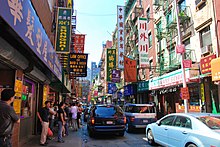
| Census | Pop. | Note | %± |
|---|---|---|---|
| 1790 | 340,120 | — | |
| 1800 | 589,051 | 73.2% | |
| 1810 | 959,049 | 62.8% | |
| 1820 | 1,372,851 | 43.1% | |
| 1830 | 1,918,608 | 39.8% | |
| 1840 | 2,428,921 | 26.6% | |
| 1850 | 3,097,394 | 27.5% | |
| 1860 | 3,880,735 | 25.3% | |
| 1870 | 4,382,759 | 12.9% | |
| 1880 | 5,082,871 | 16.0% | |
| 1890 | 5,997,853 | 18.0% | |
| 1900 | 7,268,894 | 21.2% | |
| 1910 | 9,113,614 | 25.4% | |
| 1920 | 10,385,227 | 14.0% | |
| 1930 | 12,588,066 | 21.2% | |
| 1940 | 13,479,142 | 7.1% | |
| 1950 | 14,830,192 | 10.0% | |
| 1960 | 16,782,304 | 13.2% | |
| 1970 | 18,236,967 | 8.7% | |
| 1980 | 17,558,072 | −3.7% | |
| 1990 | 17,990,455 | 2.5% | |
| 2000 | 18,976,457 | 5.5% | |
| 2010 | 19,378,102 | 2.1% | |
| 2020 | 20,201,249 | 4.2% | |
| 2023 (est.) | 19,571,216 | −3.1% | |
| Sources: 1910–2020; 2023.[1][2] | |||

According to the U.S. Census Bureau, as of 2023, New York was the fourth largest state in population after California, Texas, and Florida, with a population of 19,571,216, a decrease of over 600,000 people, or −3.1%, since the 2020 census.[2] The population change between 2000–2006 includes a natural increase of 601,779 people (1,576,125 births minus 974,346 deaths) and a decrease due to net migration of 422,481 people out of the state. Immigration from outside the United States resulted in a net increase of 820,388 people, and migration within the country produced a net loss of about 800,213.
The distribution of change in population growth is uneven in the State of New York; the New York City metropolitan area is growing considerably, along with Saratoga County, and Western New York. The rest of the state is nearly stagnant. According to immigration statistics, the state is a leading recipient of migrants from around the globe. Since 2005, immigration failed to surpass emigration, a trend that was reversed since 2006. The State of New York lost two house seats in the 2011 congressional reapportionment, secondary to relatively slow growth when compared to the rest of the United States.
The center of population of New York is located in Orange County, in the town of Deerpark. Roughly 64% of the state's population lives in the New York City metropolitan area and 40% in New York City alone.[3]

- ^ "Historical Population Change Data (1910–2020)". Census.gov. United States Census Bureau. Archived from the original on April 29, 2021. Retrieved May 1, 2021.
- ^ a b "US Census Quickfacts, Population Estimates, July 1 2023". Census.gov. United States Census Bureau. Archived (PDF) from the original on April 26, 2021. Retrieved December 21, 2023.
- ^ "Population and Population Centers by State: 2000". Archived from the original (Text) on 2013-07-05. Retrieved 2007-01-05.
- ^ "Yearbook of Immigration Statistics: 2012 Supplemental Table 1". U.S. Department of Homeland Security. Retrieved 2013-11-05.
- ^ "Yearbook of Immigration Statistics: 2011 Supplemental Table 1". U.S. Department of Homeland Security. Retrieved 2013-11-05.
- ^ "Yearbook of Immigration Statistics: 2010 Supplemental Table 1". U.S. Department of Homeland Security. Retrieved 2013-11-05.